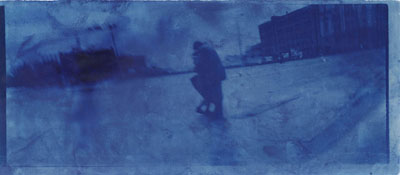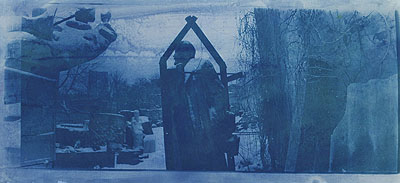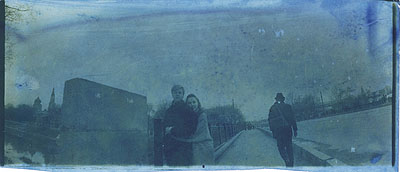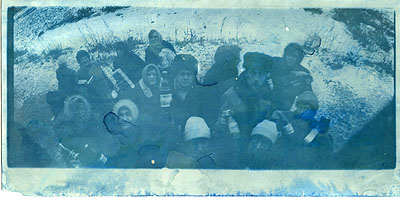
Untitled from the series At Dusk
1993
tinted photography
Courtesy the Artist / DEWEER gallery
Boris Mikhailov »
Dusk
Exhibition: 22 Feb – 5 Apr 2009
Deweer Gallery
Tiegemstraat 6 A
8553 Otegem
DEWEER GALLERY ESTATE
Tiegemstraat 6 A
8553 Otegem
+32(0)56-644893
info@deweergallery.com
www.deweergallery.com
Wed-Fri, Sun 14-18

Untitled from the series At Dusk
1993
tinted photography
Courtesy the Artist / DEWEER gallery
With the show 'Boris Mikhailov - Dusk', Deweer Gallery is the first to introduce the work of Ukrainian photographer Boris Mikhailov in Belgium. The gallery thus expands its collaboration with artists from eastern Europe. After Ilya and Emilia Kabakov and Sergey Bratkov, among others, the focus is now on an artist who is generally recognized as one of the most important and influential photographers from the former Soviet Union.
Boris Mikhailov was born in Kharkov, Ukrainia in 1938. Unlike a lot of people from his generation like Ilya Kabakov and Eric Bulatov, who moved from Ukrainia to Moscow and then quite quickly emigrated to the West, Boris Mikhailov kept on living and working in the somewhat anonymous city of Kharkiv until well into the nineties. He was and still is attached to the vast and forgotten hinterland of the former Soviet Union; even though he now lives in Berlin, he regularly spends time in his native town.
Mikhailov, who was trained as a technical engineer, started to make photographs around 1965. He lost his job in 1966 after the KGB discovered that he had taken nude pictures of his wife with a camera that belonged to his company, and subsequently started to work as an independent photographer.
For years, he earned a living making enlargements and retouching snap shots and family pictures. His clients used them in their homes and hung the photographs on the walls like ersatz paintings. This generally accepted way of retouching photographs, a kind of photoshopping avant-la-lèttre, gave people the feeling that the 'truth' of a photographical image could be freely manipulated, an approach that paralleled some practices of the communist regime of that moment.
The same regime of that epoch also defined that photographers were not allowed to take pictures of strategically important locations, pictures taken from anything higher than the second floor of a building, pictures that were a treat to the Soviet Union's good reputation and nude pictures. Boris Mikhailov officially complied with those rules, albeit in a subtly critical way, except for the nude pictures.
From the late sixties, Mikhailov has developed a long list of thematically organized series. They are very different from each other; some show historical or documentary aspects, others are rather conceptual and still others betray Mikhailov's good sense of humour. Therefor any overview of his oeuvre shows a great diversity. The artist states that he needs this diversity of images, pictures and series, like a sum of arguments that enable him to cast a shadow of doubt on the exactness or validity of one single view or perception. This approach may have a lot to do with an innate fear which is typical for artists in general - but it certainly is essential to understand those who worked in the former Soviet Union.
For his first show at Deweer gallery, Boris Mikhailov's aim has been to make a statement instead of an overview of his 40 years of practice. In view of the economically turbulent times the world is going through at the moment, Mikhailov wanted to show how he responded to the crisis that ravaged his country in the beginning of the nineties, just after the fall of the Berlin wall. That is why he chose to show only the series 'At Dusk' (1993) and 'Case History' (1997-1998).
'At Dusk' (1993) consists of 13 panoramic photographs, tinted with blue ink. They remind us of the second World War. It is a dark and very dramatical series about some of the artist's personal recollections of world war II, during which Mikhailov was evacuated to the Ural. He remembers being woken up brutally in the middle of the night by the wailing sirens. The dark blue tints refer to these traumatic experiences and also to the upcoming capitalist system that was rapidly taking control of his post-communist country at the time he made the series. 'At Dusk' is one of Boris Mikhailov's most striking series.
'Case History' (1997-1998), another impressive series, is widely recognized as the most important work the artist ever made. It portrays the community of the homeless in Kharkov in about 500 color photographs. The series testifies of the decay of the communist Soviet Union and its ideals, of the unmasking of the Soviet myths and of the human victims this historical evolution has made. Of all series Mikhailov has created, it is also closest to what is called documentary photography in our contemporary western terminology.
But there is more to it. At the time Mikhailov portrayed them, the homeless or 'bomzhes' in Kharkov and elsewhere were a new phenomenon. They were people who tried to survive in the margins of a new society reshaped by the unsocial, hard capitalist regime that had taken the place of the former Soviet regime. With his methods, the artist took the position of an anthropologist, someone who is observing the dynamics within a group.
Mikhailov did not avoid any moral questions while doing so and he is very conscious of the difficult position he takes in relation to his subjects: "What is a photographer to do? How should I act as an artist? I was very well aware of the fact that taking pictures of the poverty I saw around me and that I could not deny, was my civil and professional duty. On the other hand I also understand the traditional critique which says that you should not use the misery of others."
Mikhailov deliberately chose to act according to the new capitalist system by paying his 'models' for their work. The apparent documentary point of view thereby undergoes a shift towards a kind of staged self-consciousness, even though it only painfully accentuates the impotence of the people portrayed. The artist commented on the problem: 'I wanted to transpose the form of the relations as they were emerging in society to the relationship between the model and me. For 'Case History', Boris Mikhailov won the Krazna-Krausz Photography Book Award in 1999.
In his 40 year long career, Boris Mikhailov has accumulated an impressive list of prizes and exhibitions. He showed his work at the Museum of Modern Art in New York (1993), at Portikus, Frankfurt (1995), at the Kunsthalle Zürich (1996), the DAAD-Galerie in Berlin (1997), the Stedelijk Museum Amsterdam (1998), the Sprengel Museum in Hannover (1998 en 2007), at the Centre National de la Photographie in Paris and the Museum of Modern Art in Ljubliana (1999), at Tate Modern in London and more recently at the Fotomuseum Winterthur (2003), the Institute of Contemporary Art, Boston, MA (2004), the Centre de la Photographie in Genève (2005) and the Venice Biennial (2007). In 2000 Boris Mikhailov won the Hasselblad Foundation International Award in Photography for his oeuvre.

Untitled from the series At Dusk
1993
tinted photography
Courtesy the Artist / DEWEER gallery

Untitled from the series At Dusk
1993
tinted photography
Courtesy the Artist / DEWEER gallery